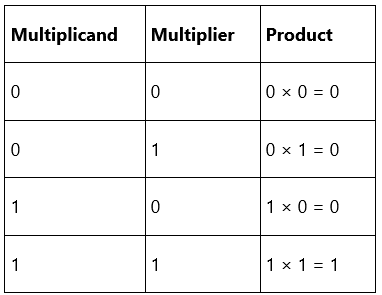Multiplication in Binary | Mathematics for JAMB PDF Download
Binary multiplication is the process of multiplying binary numbers. The process of multiplying binary numbers is the same as that of arithmetic multiplication with decimal numbers. The only difference is that binary multiplication involves numbers that are consist of 0s and 1s, whereas, decimal multiplication involves numbers that comprise digits from 0 to 9.
Binary Multiplication Rules
Binary multiplication is similar to the multiplication of decimal numbers. We have a multiplier and a multiplicand. The result of multiplication results in a product. Since only binary digits are involved in binary multiplication, we get to multiply only 0s and 1s. The rules for binary multiplication are as follows.

How to Multiply Binary Numbers?
The process of multiplying binary numbers is similar and easier to do than decimal multiplication as binary numbers consist of only two digits which are 0 and 1. The method of multiplying binary numbers is given below. The same set of rules also apply to binary numbers with a decimal point. Let us take the example of multiplying (11101)2 and (1001)2 . The decimal equivalent of (11101)2 is 29 and the decimal equivalent of (1001)2 is 9. Now let us multiply these numbers.
- Step 1: Write down the multiplicand (11101)2 and the multiplier (1001)2 one below the other in proper positions.
- Step 2: Multiply the rightmost digit or the least significant bit (LSB) of the multiplier (1) with all the digits of the multiplicand (11101)2.
- Step 3: Add a place holder of '0' or 'X' before multiplying the next higher order digit of the multiplier& with the multiplicand.
- Step 4: Repeat the same process for all the next higher-order digits until we reach the most significant bit (MSB) which is the left-most digit of the multiplicand with the multiplier.
- Step 5: The product obtained in each row is called the partial product. Finally, add all the partial products. To add all the binary numbers use the rules of binary addition.
(The rules for binary addition are listed as follows: 0 + 0 = 0, 0 + 1 = 1, and 1 + 1 = 0, with a carryover of 1. So, 1 + 1 = 10 and 1 + 1 + 1 = 11 in the binary number system)
Let us look at the following process of binary multiplication as described above.

Therefore, the product of (11101)2 and (1001)2 is (100000101)2. Let us verify our answer. The decimal equivalent of (100000101)2 is 261. To know how to convert a binary number to a decimal number, click here. The decimal equivalent of& (11101)2 is 29 and the decimal equivalent of (1001)2 is 9. When we multiply 29 and 9 the product is 261. The decimal equivalent of (100000101)2 is 261. Hence, the product is correct.
|
139 videos|82 docs|101 tests
|


















